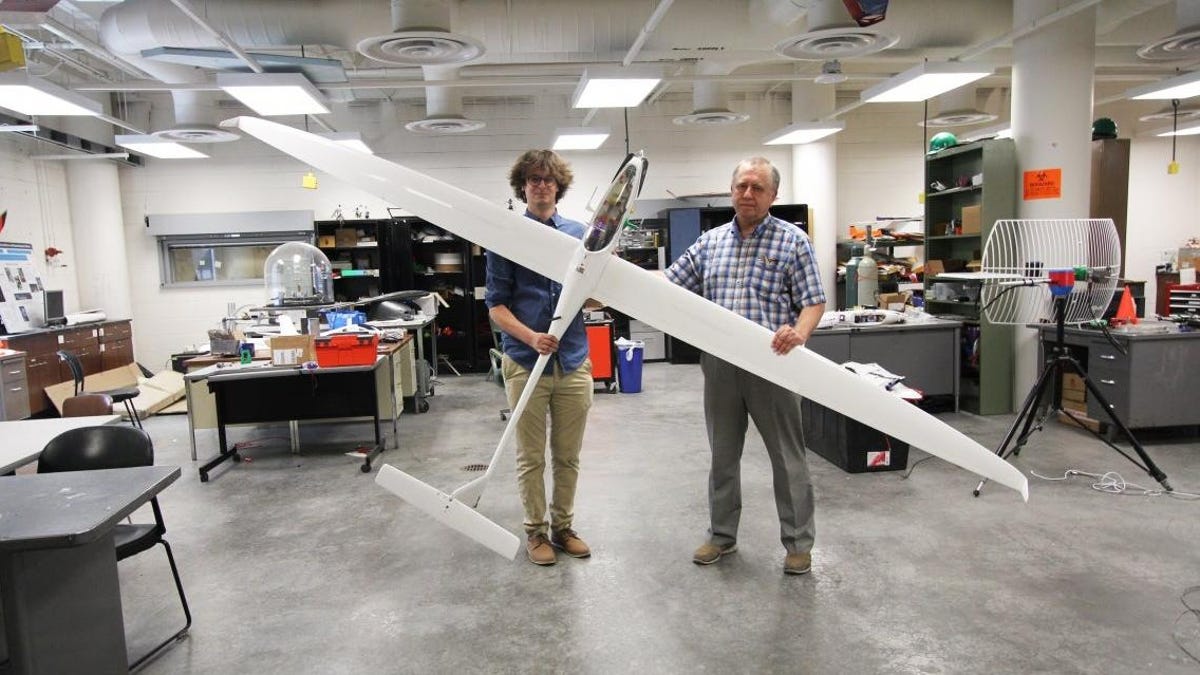This Albatross-Like Plane Could One Day Fly Over Mars

On April 19, 2021, NASA’s Ingenuity helicopter became the first powered aircraft to lift off from the surface of Mars. The historic 39-second flight set the stage for an entirely new way of exploring other planets, inspiring engineers to design bigger and more durable aircraft to soar over the Martian terrain.
A team of engineers from the University of Arizona have designed a motorless sailplane that might eventually take flight on Mars, where it would sail on winds for days at a time. An early prototype of the sailplane recently completed a small test flight while tethered to a balloon. The team is planning further tests of the system at higher altitudes towards the end of the summer, according to a press release.
Flying a plane on the Red Planet is much more challenging than on Earth due to the achingly thin atmosphere on Mars. The Martian air is less than one percent the density of Earth’s atmosphere, which makes it difficult for aircraft to stay aloft. NASA’s Ingenuity weighs only 4 pounds and generates liftoff through two carbon fiber rotors that spin much faster than on any helicopter on Earth. But Ingenuity comes with limitations, including solar powered panels that charge it for a single 90-second flight. The sailplane design concept, on the other hand, will allow the aircraft to soar for days at a time and in the same way an albatross flies through the sky on a long journey, while also forming an S-shaped pattern that helps it gain speed.
The sailplane itself is light, weighing roughly 11 pounds (5 kilograms) and having a wingspan that stretches some 11 feet (3 meters). With sufficient vertical winds, the plane could effortlessly (though theoretically) soar through the Martian skies. Otherwise, it could engage in dynamic soaring, flying at a slight upward angle into the slow-moving winds found at lower altitudes and then turning 180 degrees once it reaches higher altitudes with faster moving winds. Winds would propel the plane forward, albeit at a slightly downward facing angle, and when reaching the lower altitudes it would repeat the same process by going up and down in a squiggly line. This technique could allow the sailplane to fly for hours or even days at a time, according to the researchers’ study, published in Aerospace. The team is also considering whether it should attach the sailplane to a balloon or blimp that would carry it up towards the upper atmosphere.
So far, Martian rovers have trekked across the surface of Mars, while orbiting spacecraft have mainly probed the atmosphere. The sailplane would explore an overlooked but crucial part of the planet—the region where its atmosphere and surface interact.
“You have this really important, critical piece in this planetary boundary layer, like in the first few kilometers above the ground,” Alexandre Kling, a research scientist at NASA’s Mars Climate Modeling Center, said in a statement. “This is where all the exchanges between the surface and atmosphere happen. This is where the dust is picked up and sent into the atmosphere, where trace gases are mixed, where the modulation of large-scale winds by mountain-valley flows happen. And we just don’t have very much data about it.”
Given that it’s so light, the sailplane could potentially hitch a ride to Mars alongside a larger payload, much like the way Ingenuity was tucked into the Perseverance rover’s belly during its journey to the Red Planet. Once it reaches Mars, the sailplane could potentially drop from a CubeSat and autonomously unfurl its wings once on the surface.
The team of engineers behind the sailplane will conduct more tests later this summer, flying the sailplane at higher altitudes of 15,000 feet above sea level (4,500 meters) where the atmosphere is much thinner. “We can use the Earth as a laboratory for studying flight on Mars,” Sergey Shkarayev, aerospace and mechanical engineering professor at University of Arizona, said in a statement. Once tests are complete, the team hopes to launch the sailplane for a mission on Mars at some point within the next few years.
More: Thrilling New Video Shows Ingenuity Helicopter’s Record-Breaking Flight Over Mars
Source link





